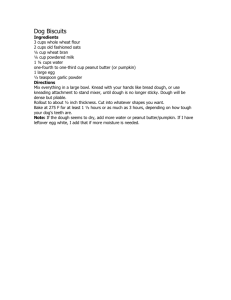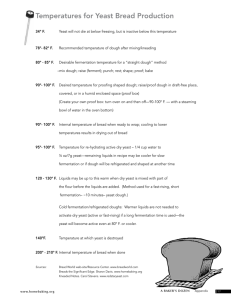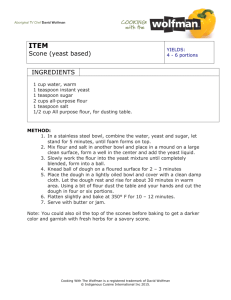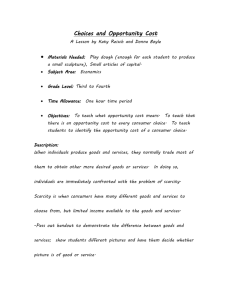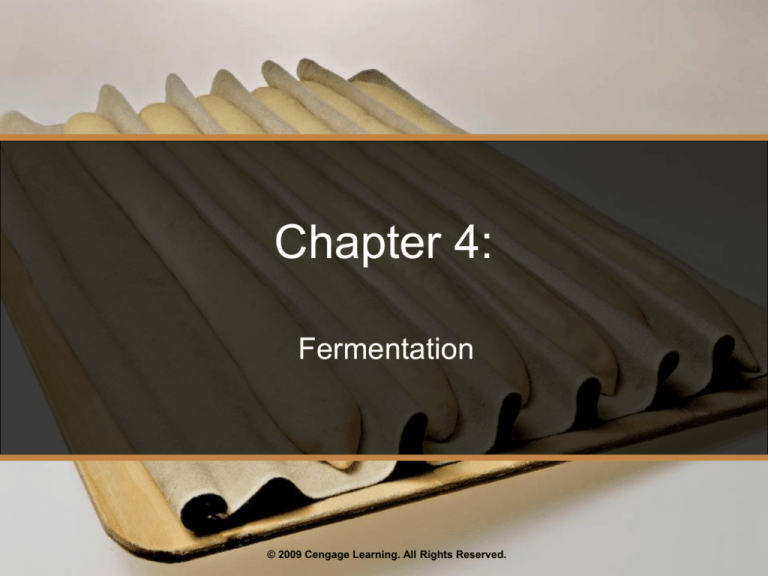
Chapter 4:
Fermentation
© 2009 Cengage Learning. All Rights Reserved.
Fermentation
CHAPTER
• Fermentation = the breakdown of compound
molecules in organic substances under the
effect of yeast or bacteria
• It starts when flour and water come into a
contact
• In baking, it occurs when some of the sugar or
glucide is converted into alcohol and carbon
dioxide under the effect of commercial or
natural yeast and bacteria
© 2009 Cengage Learning. All Rights Reserved.
4
Fermentation
CHAPTER
• Sugar Transformation
– Flour contains various types of glucides
– More complex glucides must be degraded by
enzymes or organic substances
– Less complex glucides are used as is
© 2009 Cengage Learning. All Rights Reserved.
4
Fermentation:
Sugar Transformation
• Complex Glucides
CHAPTER
4
– Saccharose and Maltose
– Represent 1% of flour
– During the first 30 minutes of fermentation time,
Enzyme breaks them down into simple sugars
– Saccharose breaks down into glucose and Fructose
– Maltose breaks down into glucose
© 2009 Cengage Learning. All Rights Reserved.
Fermentation:
Sugar Transformation
• Very Complex Glucides
– Starch
– Represents 70% of flour
– Two types: Amylose and Amylopectin
– Amylose is broken down into maltose by beta
amylase enzyme
– Amylopectin is broken down into dextrin by alpha
amylase enzyme, and dextrin is degraded into
maltose
© 2009 Cengage Learning. All Rights Reserved.
CHAPTER
4
Fermentation:
Sugar Transformation
CHAPTER
• Simple Glucides
– Glucose and Fructose
– Represent 0.5% of flour
– First sugar to be used in the fermentation
– Used within the first 30 minutes of the fermentation
process
– Easy transformation to alcohol and carbon dioxide
– Starch is damaged during the milling process
– Damaged parts of starch (from the milling process)
absorb water, and triggers the enzymatic activity
© 2009 Cengage Learning. All Rights Reserved.
4
Fermentation
CHAPTER
• Importance of Enzymatic Balance in the Flour
– Alpha and Beta amylase enzymes naturally present
in the flour
– The germination of the wheat varies the amount of
alpha amylase
– When sprouting, the germ sends enzymes to the
endosperm, which transform the complex
components into smaller nutrients that are
immediately usable by the germ
© 2009 Cengage Learning. All Rights Reserved.
4
Fermentation
CHAPTER
•
4
Effects of Fermentation Activity on Dough
1. Rising of the dough due to the carbon dioxide
production
– Internal accumulation of gas stretches the gluten
structure of the dough
– The dough’s impermeability, extensibility and
elasticity, the gluten is capable to retain the gas
© 2009 Cengage Learning. All Rights Reserved.
Fermentation
CHAPTER
•
4
Effects of Fermentation Activity on Dough
2. Acidification of dough
– pH lowers due to the production of organic acids
– Delays staling of the dough and increase shelf life
– More elasticity, less extensibility
© 2009 Cengage Learning. All Rights Reserved.
Fermentation
CHAPTER
• Factors Affecting Fermentation
– Amount of yeast
– Amount of Salt and sugar
– Temperature
– Dough pH
© 2009 Cengage Learning. All Rights Reserved.
4
Fermentation:
Factors Affecting Fermentation
• Amount of Yeast
– The amount of yeast must be limited to control
fermentation
• Temperature
– Yeast is highly active at higher temperature, and
slower at lower temperature
– Desired Dough Temperature: 76°F
© 2009 Cengage Learning. All Rights Reserved.
CHAPTER
4
Fermentation:
Factors Affecting Fermentation
• Amount of Salt and Sugar
– Salt slows down fermentation activity
– Generally, salt is 2% of the flour weight
– A small amount of sugar (5%) speeds up the
fermentation process (simple sugar = nutrients)
– A larger amount (13% or more) will slow down
fermentation
© 2009 Cengage Learning. All Rights Reserved.
CHAPTER
4
Fermentation:
Factors Affecting Fermentation
CHAPTER
4
• Dough pH
– Commercial yeast works best when pH is 4-6
– Natural yeast prefers lower pH
© 2009 Cengage Learning. All Rights Reserved.
Fermentation
CHAPTER
• Relationship between Fermentation and
Dough Handling
– Bread characteristics are determined by the baking
process
– Baking process: Dough Handling (mixing, dividing,
shaping, scoring, baking) and Fermentation Time
(dough evolves by itself)
– The baking processes are interconnected, and one
affects on others
© 2009 Cengage Learning. All Rights Reserved.
4
Fermentation
CHAPTER
• Relationship between First Fermentation and
Mixing
– A long fermentation provides increased flavor and
shelf life to the final product
– During mixing, the hook develops the gluten by
stretching and folding
– The longer the mixing, the stronger the gluten
– Mixing time needs to be decreased to have a long
fermentation time
© 2009 Cengage Learning. All Rights Reserved.
4
Fermentation
CHAPTER
• Relationship between First Fermentation and Mixing
– Short mixing time limits oxidation of the dough
– Requires folding technique to compensate the underdeveloped gluten
– Folding reorganizes the gluten structure
– It expulses the gas accumulated in the dough
• Relationship between First Fermentation and Dividing
– Gluten strands become more fragile – avoid damaging the
dough during dividing
© 2009 Cengage Learning. All Rights Reserved.
4
Fermentation
CHAPTER
• Relationship between First Fermentation and
Dividing
– Gluten strands become more fragile – avoid
damaging the dough during dividing
• Relationship between Dough Characteristics
and Pre-shaping
– If the dough have insufficient or excessive strength,
it can be corrected during pre-shaping
© 2009 Cengage Learning. All Rights Reserved.
4
Fermentation
CHAPTER
• Relationship between Dough Characteristics
and Shaping
– The dough characteristics can be balanced during
shaping: last opportunity
• Relationship between Final Proof and Shaping
– Dough shaped through machine takes longer time
to ferment
– Hand-shaped dough takes shorter time to proof
© 2009 Cengage Learning. All Rights Reserved.
4
Fermentation
CHAPTER
• Relationship between Dough Characteristics
and Scoring
– Over-proofed dough: shallow scoring
– Under-proofed dough: deep scoring
– The way to score changes the appearance of the
final product: choose the scoring according to the
dough characteristics
© 2009 Cengage Learning. All Rights Reserved.
4
Fermentation
CHAPTER
• Preferments
– Dough or batter created from a portion of the total
formula’s flour, water, yeast and sometimes salt
– Improves bread quality, strength and aroma
• Types of Preferments
– Pre-fermented Dough
– Poolish
– Sponge
– Biga
© 2009 Cengage Learning. All Rights Reserved.
4
Types of Preferment
CHAPTER
• Pre-Fermented Dough
– Dough made with flour, water, yeast and salt
– A piece of dough from previous mix can be used as a pre-fermented
dough
• Poolish
–
–
–
–
Derived by Polish bakers
Choice of preferment for baguette dough
100% hydration
Provides mild acidity and extensibility
© 2009 Cengage Learning. All Rights Reserved.
4
Types of Preferments
CHAPTER
4
• Sponge
– Used for pan bread production in England
– Popularly used in enriched dough
– Improves flavor and strength of the dough
• Biga
– From Italy
– Traditionally contains 50-55% water, but it varies
– Provides dough strength
© 2009 Cengage Learning. All Rights Reserved.
Preferments
CHAPTER
• Advantages and Drawbacks of Preferment
– Advantages
• Gas Production
• Alcohol Production
• Acid Production
© 2009 Cengage Learning. All Rights Reserved.
4
Fermentation:
Preferments
• Advantages and Drawbacks of Preferment
– Drawbacks
• Additional work required
• Extra space for storage (refrigerated/room temp)
• Potential inability to plan exact amount of preferment
© 2009 Cengage Learning. All Rights Reserved.
CHAPTER
4
Preferments
CHAPTER
• Technical Considerations
– Mixing Preferments
• Stiff Preferment: Mix on first speed for 5 – 8 minutes
• Liquid Preferment: Mix with a paddle attachment
© 2009 Cengage Learning. All Rights Reserved.
4
Fermentation:
Preferments
• Technical Considerations
– Incorporation in the Final Dough
• Timing and Quantity
• Secondary Effects of Preferment
– Enzyme provokes sugar and protein degradation
– Amylase and Protease
© 2009 Cengage Learning. All Rights Reserved.
CHAPTER
4
Fermentation
CHAPTER
4
• Sourdough
– By accident, first created in Egypt between 40003000 BCE.
• General Sourdough Process
– Start a culture of microorganisms and increase the
quantity to ferment the dough
© 2009 Cengage Learning. All Rights Reserved.
Sourdough
CHAPTER
• Microorganisms Involved in the Sourdough
Process
4
– Yeast and Bacteria
– Found in air, water, flour, etc
– Yeast transforms simple sugars to alcohol and gas
– Bacteria converts certain sugars into lactic and acetic
acid
© 2009 Cengage Learning. All Rights Reserved.
Sourdough
CHAPTER
• Starting a Culture
– A controlled culture of microorganisms requiring
food (flour), water and oxygen
– Organic Flour and the addition of rye or whole
wheat flour will increase micro organism activity
© 2009 Cengage Learning. All Rights Reserved.
4
Fermentation:
Sourdough
• Culture Elaboration
– Both aerobic and anaerobic activity of
microorganisms (yeast and bacteria)
– Stronger flora flourish and become established
(natural selection)
– Culture is “fed” at predetermined intervals to
maintain activity of microorganisms
© 2009 Cengage Learning. All Rights Reserved.
CHAPTER
4
Fermentation:
Sourdough
• From Starter to Levain
– Starter is elaborated until needed in formula
– Levain is the preferment to be used to leaven final
dough
– If more activity is needed to achieve the mature
levain, the quantity of starter may be increased in
the levain feeding
© 2009 Cengage Learning. All Rights Reserved.
CHAPTER
4
Fermentation:
Sourdough
• Perpetuating the Culture
– Option 1: remove a piece of the final dough before
the addition of the salt
– Option 2: increase levain quantity and remove
required quantity of started to perpetuate
– More consistent results occur when the starter is
taken from the levain
© 2009 Cengage Learning. All Rights Reserved.
CHAPTER
4
Fermentation:
Sourdough
• Factors Affecting Culture Characteristics
– Hydration: water content affects flora activity
• Stiff culture will have tendency to develop more acetic
acidity (more acidic flavor)
• Liquid culture will increase the production of lactic acidity
(less acidic flavor)
© 2009 Cengage Learning. All Rights Reserved.
CHAPTER
4
Fermentation:
Sourdough
• Factors Affecting Culture Characteristics
– Temperature
– 85°F (29°C) to 90F (32°C) favors bacterial
activity and the production of lactic acidity, but
fermentation is more difficult to control
– 77F (25°C) optimizes fermentation activity, the
development of the dough, and the production of
aromas.
© 2009 Cengage Learning. All Rights Reserved.
CHAPTER
4
Fermentation:
Sourdough
CHAPTER
• Factors Affecting Culture Characteristics
– Flour
• Enzyme and bran content determine the amount of simple
sugar and minerals available for the microorganisms
• Higher extraction flours provide better activity and higher
acid production
© 2009 Cengage Learning. All Rights Reserved.
4
Fermentation:
Sourdough
• Factors Affecting Culture Characteristics
– Salt
• 0.1 percent can be beneficial for a culture with high
protease activity
• More than 0.1 percent can inhibit the activity of some
microorganisms.
© 2009 Cengage Learning. All Rights Reserved.
CHAPTER
4
Fermentation:
Sourdough
CHAPTER
• Maintaining the Culture
– Consistency
• Feedings should be regulated: ratio, type and temperature
of ingredients. Mixing and storage.
– Sanitation
• Always use clean equipment and practice good hygiene.
– Contamination
• Prevent contamination from commercial yeast.
© 2009 Cengage Learning. All Rights Reserved.
4
Fermentation:
Sourdough
• Troubleshooting Sourdough Culture
– Too little Acidity/Too much Acidity
– Lack of development in the bread
– Lack of strength in the levain.
© 2009 Cengage Learning. All Rights Reserved.
CHAPTER
4
Fermentation:
Sourdough
• Use in Final Dough
• Proportion of levain
– Related to dough and bread characteristics
• Strength
• Flavor (acidity level)
• Use for different types of product
– Possibility to develop different cultures with different
characteristics
• Whole Wheat, Rye
• Sweet dough
© 2009 Cengage Learning. All Rights Reserved.
CHAPTER
4
Fermentation
CHAPTER
• Fermentation Process Conclusion
4
– Fermentation affects flavor, appearance and
keeping qualities of bread.
– From poolish to sourdough, the baker has a lot to
consider in terms of flavor, production schedule, and
technical considerations.
– The baker must learn to evaluate dough at all
stages to have a solid understanding of the product
and end subsequent end results.
© 2009 Cengage Learning. All Rights Reserved.
Retarding Process
CHAPTER
4
• Retarding:
– stopping the fermentation of the dough at various
points in the process
• Technical Considerations
– Temperature
– Gas Production
– Gas Retention
– Natural Dough Degradation
© 2009 Cengage Learning. All Rights Reserved.
Retarding Process:
Technical Considerations
• Temperature
– Ferments in baking are sensitive to temperature.
– Optimal temperature for fermentation is 74°-80°F.
– At lower temperatures, ferments slow down their
metabolism.
– When the temperature reaches 40°F (4°C),
ferments become dormant and most activity is
stopped.
© 2009 Cengage Learning. All Rights Reserved.
CHAPTER
4
Retarding Process:
Technical Considerations
CHAPTER
• Gas Production
– Depends on temperature of retarding process and
quantity of yeast.
– Freshness and quality of the yeast is important.
– In a sourdough process, gas production will depend
on the culture fermentation activity.
• Liquid vs. Stiff cultures
© 2009 Cengage Learning. All Rights Reserved.
4
Retarding Process:
Technical Considerations
• Gas Retention
– The goal of the retarding process is to delay as long as
possible the point where the gluten reaches maximum
extensibility and breaks under the pressure of the gas.
– A short first fermentation time is necessary to delay the point
where the dough reaches its gas retention limit.
– Flour with low starch damage slows fermentation activity.
– To delay gas production at the beginning of the process, the
DDT is 73°F (23°C).
© 2009 Cengage Learning. All Rights Reserved.
CHAPTER
4
Retarding Process:
Technical Considerations
CHAPTER
• Natural Dough Degradation
– Occurs when flour and water are put in contact and it
continues as the fermentation progresses.
– Most dough degradation happens because of protease.
– To delay degradation start with dough that is strong enough to
withstand retarding.
– Some adaptations can be made during mixing.
• Hydration can be slightly lower
• Stiffer dough will provide a stronger gluten structure.
• Mixing time must be calculated to sufficiently develop the dough
and obtain a strong organized gluten structure.
© 2009 Cengage Learning. All Rights Reserved.
4
Retarding Process:
Basic Retarding Techniques
CHAPTER
• Delayed First Fermentation
4
– After mixing, retard dough at 45°F (7°C) to 48°F (9°C).
The retarding time can last from 12 to 18 hours.
– After retarding, take the dough out of the retarder and divide it
right away, or wait about 1 hour before scaling.
– Divide and preshape as normal. A longer resting time will be
necessary to allow the dough to warm up and restart
fermentation.
– Complete normal shaping and final proof and bake at the usual
temperature and time
© 2009 Cengage Learning. All Rights Reserved.
Retarding Process:
Basic Retarding Techniques
CHAPTER
• Delayed First Fermentation: Advantages
– At 45°F (7°C) to 48°F (9°C) gas and acidity production is
still happening at a lower rate but for a longer period of time.
– When good quality flour is used, there is no need for dough
conditioners such as ascorbic acid, keeping the product
labeling cleaner.
– Because the dough is retarded in bulk before shaping, no
blisters are formed during baking.
– The baker can organize production to offer customers fresh
bread all day long without mixing too many batches of dough.
© 2009 Cengage Learning. All Rights Reserved.
4
Retarding Process:
Basic Retarding Techniques
• Delayed First Fermentation: Drawbacks
– This technique requires a retarder with enough
capacity to store a large amount of dough.
– The bread cannot be baked immediately after
retarding. Three to four hours are necessary to
divide, shape, proof and bake the bread.
© 2009 Cengage Learning. All Rights Reserved.
CHAPTER
4
Retarding Process
CHAPTER
• Slow Final Proof
– Mix to achieve between an improved mix and an
intensive mix
– The amount of fresh yeast: 0.8 to 1 percent.
– A longer fermentation time calls for a lower
percentage of yeast.
– Preferment is advised, and the DDT is 73°F
(23°C).
© 2009 Cengage Learning. All Rights Reserved.
4
Retarding Process:
Basic Retarding Techniques
CHAPTER
• Slow Final Proof
4
– Method
– After mixing, allow the dough to ferment 20 to 30
minutes and then divide, preshape and shape as
normal
– Place the shaped dough in the retarder set at 50°F
(10°C).
– Retard for 12 to 15 hours and bake directly from the
retarder
© 2009 Cengage Learning. All Rights Reserved.
Retarding Process:
Basic Retarding Techniques
• Slow Final Proof
– Advantages
– Dough can be baked after removing it from the
retarder after 12 hours
– Baked after 12 or 15 hours
– Plan production to have fresh bread for breakfast
and lunch without mixing too many batches of
dough
© 2009 Cengage Learning. All Rights Reserved.
CHAPTER
4
Retarding Process:
Basic Retarding Techniques
CHAPTER
• Slow Final Proof
4
– Drawbacks
– Retarding space is required.
– 15 to 20 ppm ascorbic acid is necessary to reinforce
the gluten structure of the dough.
– The surface of the loaves can become dehydrated.
For this reason, it is important to have a good
humidifier system.
© 2009 Cengage Learning. All Rights Reserved.
Retarding Process:
Basic Retarding Techniques
CHAPTER
• Retarding-Proofing Process
–
–
–
–
Method
Mix to achieve between an improved mix and an intensive mix
Preferment is definitely advised. DDT is 73°F (23°C)
After mixing, divide and preshape the dough; then allow it to
ferment for 20 to 30 minutes. Let it rest for 20 minutes and
shape more tightly than usual
– Place the shaped pieces of dough in the retarder set at 38°F
(3°C) to 40°F (4°C). Retard for 12 to 48 hours
– Remove the dough from the retarder and leave it at room
temperature for the final proof
© 2009 Cengage Learning. All Rights Reserved.
4
Retarding Process:
Basic Retarding Techniques
• Retarding-Proofing Process
– Advantages
– Possible to bake right away the next day
– Allows better work organization
– Better quality of life
• Night hours more limited
© 2009 Cengage Learning. All Rights Reserved.
CHAPTER
4
Retarding Process:
Basic Retarding Techniques
• Retarding-Proofing Process
– Drawbacks
– Energy cost
– Flour issue
• Dough conditioners may be necessary
– Equipment considerations
• Floor space
• Proofer retarder needed
• Good humidity regulation in proofer to avoid crusty dough
© 2009 Cengage Learning. All Rights Reserved.
CHAPTER
4
Retarding Process
CHAPTER
• Sourdough in the Retarding Process
4
– Sourdough is beneficial to the retarding process
– Higher levels of acidity reinforces the strength of the
dough
– Dough conditioners are not typically necessary
– Rye and whole-wheat flours can easily be used in
the retarding process
© 2009 Cengage Learning. All Rights Reserved.
Retarding Process
CHAPTER
4
• Equipment
– Retarders or proofer-retarders
– Temperature, humidity production, and air diffusion
© 2009 Cengage Learning. All Rights Reserved.
Retarding Process
CHAPTER
• Retarding Conclusion
– Fresh product all day long
– Enables more diversified product line
– Better work organization
– Better quality of life
© 2009 Cengage Learning. All Rights Reserved.
4
Dough Strength
CHAPTER
• Balance among three main physical dough
characteristics
• Extensibility
– Property of the dough to be stretched
• Elasticity
– Property of the dough to return to its initial position after being
stretched
• Tenacity
– Property of the dough to resist to a stretching action
© 2009 Cengage Learning. All Rights Reserved.
4
Dough Strength
CHAPTER
• Strong Dough Versus Weak Dough
• Strong dough
– Lack of extensibility
– Excess of tenacity
– Very elastic
• Weak dough
– Excess of extensibility
– Lack of tenacity
– Lack of elasticity
© 2009 Cengage Learning. All Rights Reserved.
4
Dough Strength
CHAPTER
• Factors Affecting Dough Strength
– Ingredients
– Mixing
– Fermentation
– Handling of the dough
© 2009 Cengage Learning. All Rights Reserved.
4
Dough Strength
CHAPTER
4
• Ingredients
• Flour characteristics
– Protein quantity and quality
– Ash content
– Treatments
– Maturation
• Water
– Dough hydration
• Others ingredients
– Fat, sugar, seeds
© 2009 Cengage Learning. All Rights Reserved.
Dough Strength
CHAPTER
4
• Mixing
• Use of an autolyse
– Affect the gluten of the dough
• Mixing time
– Dough development
• Dough temperature
– Affect fermentation activity
© 2009 Cengage Learning. All Rights Reserved.
Dough Strength
CHAPTER
• Fermentation
• Length of the first fermentation
• Quantity of dough
– Mass effect
• Use of preferment
– Type
– Quantity used in the final dough
– Degree of maturation
© 2009 Cengage Learning. All Rights Reserved.
4
Dough Strength
CHAPTER
• Dough Handling
• Dividing and scaling
– By hand or by machine
• Preshaping
• Shaping
– Tightness
• Scoring
– Different scoring patterns
© 2009 Cengage Learning. All Rights Reserved.
4
Conclusion
CHAPTER
• Fermentation is a critical step in baking
4
• The quality of bread is a result of the type of
fermentation
• Choices: straight dough, preferments, retarding
processes
© 2009 Cengage Learning. All Rights Reserved.



